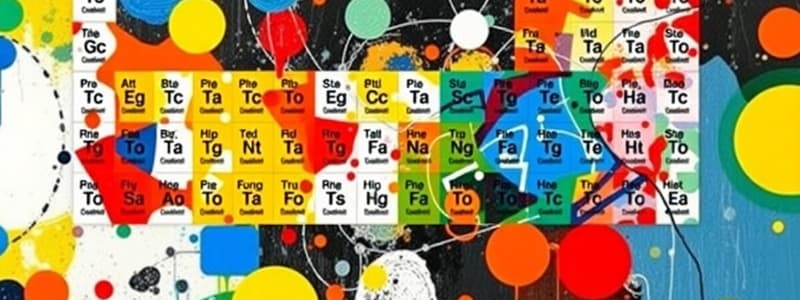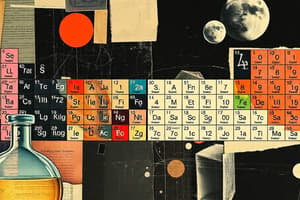Podcast
Questions and Answers
Which of the following statements about atomic radius is true?
Which of the following statements about atomic radius is true?
- Atomic radius increases across a period.
- Atomic radius decreases down a group.
- Atomic radius generally decreases across a period. (correct)
- Atomic radius does not change in periodic trends.
Ionization energy decreases as you move from left to right across a period.
Ionization energy decreases as you move from left to right across a period.
False (B)
What is the term for the energy change when an electron is added to a neutral atom?
What is the term for the energy change when an electron is added to a neutral atom?
Electron affinity
Group 17 elements are known as ______.
Group 17 elements are known as ______.
Which element is known to be the most electronegative?
Which element is known to be the most electronegative?
Match the following groups with their characteristics:
Match the following groups with their characteristics:
Metalloids are typically good conductors of electricity.
Metalloids are typically good conductors of electricity.
What is the periodic law?
What is the periodic law?
Flashcards
Periodic Table
Periodic Table
A tabular arrangement of chemical elements by atomic number and properties.
Atomic Radius
Atomic Radius
Distance from the nucleus to the outermost electron shell; decreases across a period and increases down a group.
Ionization Energy
Ionization Energy
Energy needed to remove an electron from an atom; increases across a period and decreases down a group.
Electron Affinity
Electron Affinity
Signup and view all the flashcards
Electronegativity
Electronegativity
Signup and view all the flashcards
Metals
Metals
Signup and view all the flashcards
Nonmetals
Nonmetals
Signup and view all the flashcards
Noble Gases
Noble Gases
Signup and view all the flashcards
Study Notes
Topic Subtitle
- The periodic table is a tabular arrangement of chemical elements, ordered by atomic number, electron configuration, and recurring chemical properties.
- Elements are arranged in rows (periods) and columns (groups or families).
- Elements in the same group share similar chemical properties due to having the same number of valence electrons.
Trends in the Periodic Table
- Atomic radius: Decreases across a period (left to right) due to increasing nuclear charge, pulling electrons closer to the nucleus. Increases down a group (top to bottom) due to the addition of electron shells.
- Ionization energy: The energy required to remove an electron from an atom. Increases across a period and decreases down a group. Elements on the right side and top of the table are more difficult to ionize.
- Electron affinity: The energy change when an electron is added to a neutral atom. Becomes more negative (more exothermic) across a period and less negative down a group. Nonmetals generally have high and negative electron affinities.
- Electronegativity: The ability of an atom in a molecule to attract bonding electrons to itself. Increases across a period and decreases down a group. Fluorine is the most electronegative element.
Types of elements
- Metals: Located on the left side and center of the table. Good conductors of heat and electricity, malleable, ductile, and generally lustrous.
- Nonmetals: Located on the right side of the table. Poor conductors of heat and electricity, brittle, and often dull.
- Metalloids (Semimetals): Located along the stair-step line between metals and nonmetals. Possess properties intermediate between metals and nonmetals; conduct electricity under certain conditions.
Periodic Law
- The properties of elements are periodic functions of their atomic numbers.
Groups in the Periodic Table
- Group 1 (Alkali Metals): Highly reactive metals, readily lose an electron to form +1 ions.
- Group 2 (Alkaline Earth Metals): Reactive metals, readily lose two electrons to form +2 ions.
- Group 17 (Halogens): Highly reactive nonmetals, readily gain one electron to form -1 ions.
- Group 18 (Noble Gases): Relatively unreactive nonmetals. They have a full valence electron shell, making them stable.
Other Important Concepts
- Atomic Number: The number of protons in an atom's nucleus. Unique to each element and determines its position on the periodic table.
- Mass Number: The sum of protons and neutrons in an atom's nucleus.
- Isotopes: Atoms of the same element that have different numbers of neutrons and therefore different mass numbers.
- Ions: Atoms that have gained or lost electrons, giving them a positive or negative charge, respectively.
- Periods: The horizontal rows of the periodic table. The number of electron shells within the atoms increases as you go down a period.
- The periodic table helps to predict the chemical behavior of elements based on their location.
Studying That Suits You
Use AI to generate personalized quizzes and flashcards to suit your learning preferences.




